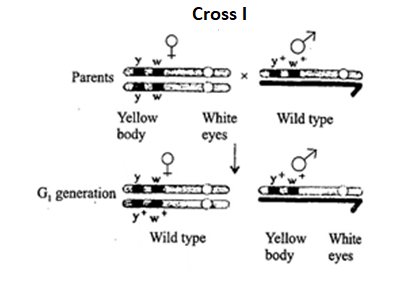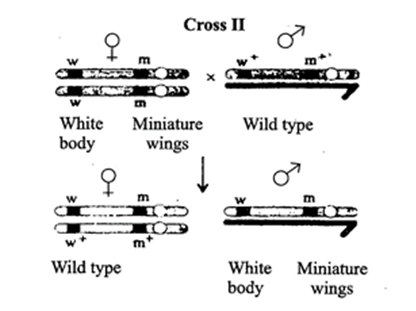
The experiment shown in the figure has been carried out by Morgan to show the phenomenon of linkage and recombination. If in Cross I, genes are tightly linked and in Cross D, genes are loosely linked then what will be the percentage of recombinants produced in Cross I and Cross II respectively?


A) 98.7% and 62.8%
B) 1.3% and 37.2%
C) 37.2% and 1.3%
D) 62.8% and 98.7%


Answer
359.1k+ views
Hint: Cross I and Cross II both produced recombinants, although at different rates (1.3% and 37.2%, respectively).
Complete Step by Step Answer:
The linking phenomenon is this. To create the F1 offspring, Thomas Morgan combined females with yellow bodies and white eyes with men with brown bodies and red eyes. The F1 generation was then crossed with the F2 generation. Cross I was this. He bred wild-type males with white-bodied females that had little wings. Cross II was this. The gene did not follow Mendel's law of independent assortment, he observed.
In cross I
Due to their close genetic relationships, the yellow and white genes revealed a 1.3% recombination rate.
In cross II
Due to their loose connections, the white and tiny genes displayed a recombination rate of 37.2%. Morgan found that the interconnection of genes was to blame. Due to this, linked genes—genes that inherit jointly in the progeny—are the consequence.
Hence, option B is the correct answer.
Note: Gene inheritance is characterised by events such as linkage and recombination. When two or more connected genes are invariably inherited in the same combination for more than two generations, this is referred to be a linkage. The test cross progeny never had recombination frequencies higher than 50%.
Complete Step by Step Answer:
The linking phenomenon is this. To create the F1 offspring, Thomas Morgan combined females with yellow bodies and white eyes with men with brown bodies and red eyes. The F1 generation was then crossed with the F2 generation. Cross I was this. He bred wild-type males with white-bodied females that had little wings. Cross II was this. The gene did not follow Mendel's law of independent assortment, he observed.
In cross I
Due to their close genetic relationships, the yellow and white genes revealed a 1.3% recombination rate.
In cross II
Due to their loose connections, the white and tiny genes displayed a recombination rate of 37.2%. Morgan found that the interconnection of genes was to blame. Due to this, linked genes—genes that inherit jointly in the progeny—are the consequence.
Hence, option B is the correct answer.
Note: Gene inheritance is characterised by events such as linkage and recombination. When two or more connected genes are invariably inherited in the same combination for more than two generations, this is referred to be a linkage. The test cross progeny never had recombination frequencies higher than 50%.
Recently Updated Pages
Given diagram showing a typical agarose gel electrophoresis class 13 biology NEET_UG

Capping is a process in which A adenylate is added class 12 biology NEET_UG

Explain in brief the separation and isolation of DNA class 12 biology NEET_UG

Number of testicular lobules in testes is A 250 B 500 class 12 biology NEET_UG

Master Class 12 Business Studies: Engaging Questions & Answers for Success

Master Class 12 Economics: Engaging Questions & Answers for Success

Trending doubts
What is BLO What is the full form of BLO class 8 social science CBSE

Which places in India experience sunrise first and class 9 social science CBSE

Differentiate between an exothermic and an endothermic class 11 chemistry CBSE

The shortest day of the year in India

What are the major means of transport Explain each class 12 social science CBSE

Which are the Top 10 Largest Countries of the World?




